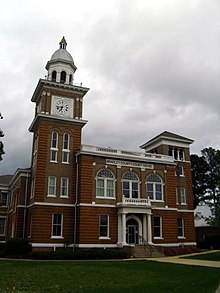Bradley County, Arkansas
| Bradley County, Arkansas | |
|---|---|

Bradley County Courthouse
|
|
 Location in the U.S. state of Arkansas |
|
 Arkansas's location in the U.S. |
|
| Founded | December 18, 1840 |
| Named for | Hugh Bradley |
| Seat | Warren |
| Largest city | Warren |
| Area | |
| • Total | 653 sq mi (1,691 km2) |
| • Land | 649 sq mi (1,681 km2) |
| • Water | 3.7 sq mi (10 km2), 0.6% |
| Population (est.) | |
| • (2015) | 11,094 |
| • Density | 18/sq mi (7/km²) |
| Congressional district | 4th |
| Time zone | Central: UTC-6/-5 |
| Website | www |
Bradley County is a county located in the U.S. state of Arkansas. As of the 2010 census, the population was 11,508. The county seat is Warren. It is Arkansas's 43rd county, formed on December 18, 1840, and named for Captain Hugh Bradley, who fought in the War of 1812. It is an alcohol prohibition or dry county, and is the home of the world-famous Bradley County Pink Tomato Festival.
Indigenous peoples of various cultures had lived along the rivers of Arkansas for thousands of years and created complex societies. Mississippian culture peoples built massive earthwork mounds along the Ouachita River beginning about 1000 CE.
The Felsenthal refuge at the south end of Bradley County contains over 200 native American achaeological sites, primarily from the Caddo tribe that lived in the area as long as 5,000 years ago. These sites include the remains of seasonal fishing camps, ceremonial plazas, temple mounds and large villages containing as many as 200 structures.
After Hernando de Soto's exploration of the Mississippi Valley during the 1540s, there is little evidence of any European activity in the Ouachita River valley until the latter 17th century.
Louis XIV's long reign and wars had nearly bankrupted the French monarchy. Rather than reduce spending, the Regency of Louis XV of France endorsed the monetary theories of John Law a Scottish financier. In 1716, Law was given a charter for the Banque Royale under which the national debt was assigned to the bank in return for extraordinary privileges. The key to the Banque Royale agreement was that the national debt would be paid from revenues derived from opening the Mississippi Valley. The Bank was tied to other ventures of Law—the Company of the West and the Companies of the Indies. All were known as the Mississippi Company. The Mississippi Company had a monopoly on trade and mineral wealth. The Company boomed on paper. Law was given the title Duc d'Arkansas. Bernard de la Harpe and his party left New Orleans in 1719 to explore the Red River. In 1721, he explored the Arkansas River. At the Yazoo settlements in Mississippi he was joined by Jean Benjamin who became the scientist for the expedition.
...
Wikipedia
